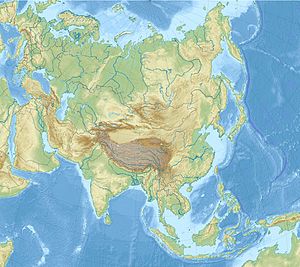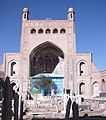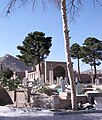Herat
This article mayrequirecleanupto meet Wikipedia'squality standards.The specific problem is:Overload of images in non-relevant sections.(August 2022) |
Herat
هرات | |
|---|---|
Left-to-right from top: Great Mosque of Herat,Herat Citadel,Herat University,panoramic view ofMusalla complex,Jama Mosque exterior, skyline of Herat city | |
| Nickname: "The Pearl of Khorasan"[1] | |
| Coordinates:34°20′31″N62°12′11″E/ 34.34194°N 62.20306°E | |
| Country | |
| Province | Herat |
| Area | |
| • Total | 182 km2(70 sq mi) |
| [2] | |
| Elevation | 920 m (3,020 ft) |
| Population | |
| • Estimate (2021) | 592,902[3] |
| Time zone | UTC+4:30(Afghanistan Standard Time) |
| Postal code | 30XX |
| Climate | BSk |
Herāt(/hɛˈrɑːt/;[4]Pashto,Dari:هرات) is anoasiscity and thethird-largest cityinAfghanistan.[5]In 2020, it had an estimated population of 574,276, and serves as the capital ofHerat Province,situated south of theParopamisus Mountains(Selseleh-ye Safēd Kōh) in the fertile valley of theHari Riverin the western part of the country. An ancient civilization on theSilk Roadbetween West, Central and South Asia,[6]it serves as a regional hub in the country's west.
Herat dates back to Avestan times and was traditionally known for itswine.The city has a number of historic sites, including theHerat Citadeland theMusalla Complex.During theMiddle Ages,Herat became one of the important cities ofKhorasan,as it was known as thePearl of Khorasan.[7]After its conquest byTamerlane,the city became an important center of intellectual and artistic life in the Islamic world.[8]Under the rule ofShah Rukh,the city served as the focal point of theTimurid Renaissance,whose glory is thought to have matchedFlorenceof theItalian Renaissanceas the center of a cultural rebirth.[9][10]After the fall of theTimurid Empire,Herat has been governed by various Afghan rulers since the early 18th century.[11]In 1716, the Abdali Afghans inhabiting the city revolted and formed their own Sultanate, theSadozai Sultanate of Herat.They were conquered by theAfsharidsin 1732.
AfterNader Shah's death andAhmad Shah Durrani's rise to power in 1747, Herat became part ofAfghanistan.[11]It becamean independent city-statein the first half of the 19th century, facing severalIranianinvasions until being incorporated intoAfghanistanin 1863.[12]The roads from Herat to Iran (through the border town ofIslam Qala) andTurkmenistan(through the border town ofTorghundi) are still strategically important. As the gateway to Iran, it collects high amount of customs revenue for Afghanistan.[13]It also has aninternational airport.Following the2001 war,the city had been relatively safe from Taliban insurgent attacks.[14]In 2021, it was announced that Herat would be listed as aUNESCO World Heritage Site.[15]On August 12, 2021, the city was seized byTalibanfighters as part of the Taliban'ssummer offensive.[16]
The area of Herat, along with areas likePiranshahr,DamghanandAleppo,are among the most important archaeological areas in the world.[17][18][19][20][21][22][23]
History[edit]
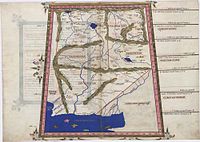
Ancient
Herat is first recorded in ancient times, but its precise date of foundation is unknown. Under the PersianAchaemenid Empire(550–330 BC), the surrounding district was known by theOld Persianname ofHaraiva(𐏃𐎼𐎡𐎺), and in classical sources, the region was correspondingly known as Areia (Aria). In theZoroastriancollection ofAvesta,the district is referred asHaroiva.The name of the district and its principal town is a derivative from that of the local river, theHerey River(fromOld IranianHarayu,meaning "with velocity" ), which goes through the district and ends 5 km (3.1 mi) south of Herat.[24]Herey is mentioned in Sanskrit as a yellow or golden color equivalent to Persian "Zard" meaning Gold (yellow). The naming of a region and its principal town after the main river is a common feature in this part of the world— compare the adjoining districts/rivers/towns ofArachosiaandBactria.
| History ofAfghanistan |
|---|
 |
| Timeline |
The districtAriaof the Achaemenid Empire is mentioned in the provincial lists that are included in various royal inscriptions, for instance, in theBehistun inscriptionofDarius I(ca. 520 BC).[25]Representatives from the district are depicted in reliefs, e.g., at the royal Achaemenid tombs ofNaqsh-e RustamandPersepolis.They are wearingScythian-style dress (with atunicandtrouserstucked into highboots) and a twistedBashlykthat covers their head, chin and neck.[26]
Hamdallah Mustawfi,composer of the 14th-century geographical workNuzhat al-Qulubwrites that:
Herāt was the name of one of the chiefs among the followers of the heroNarīmān,and it was he who first founded the city. After it had fallen to ruinAlexander the Greatrebuilt it, and the circuit of its walls was 9000 paces.[7]
Herodotusdescribed Herat asthe bread-basket of Central Asia.At the time of Alexander the Great in 330 BC, Aria was obviously an important district. It was administered by asatrapcalledSatibarzanes,who was one of the three main Persian officials in the East of the Empire, together with the satrapBessusofBactriaandBarsaentesof Arachosia. In late 330 BC, Alexander captured the Arian capital that was calledArtacoana.The town was rebuilt and the citadel was constructed. Afghanistan became part of theSeleucid Empire.
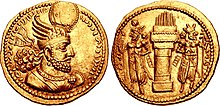
However, most sources suggest that Herat was predominantlyZoroastrian.It became part of theParthian Empirein 167 BC. In theSasanianperiod (226–652), 𐭧𐭥𐭩𐭥Harēvis listed in an inscription on theKa'ba-i ZartoshtatNaqsh-e Rustam;andHariyis mentioned in thePahlavicatalogue of the provincial capitals of the empire. In around 430, the town is also listed as having a Christian community, with aNestorianbishop.[27]
In the last two centuries of Sasanian rule, Aria (Herat) had great strategic importance in the endless wars between the Sasanians, theChionitesand theHephthaliteswho had been settled in the northern section of Afghanistan since the late 4th century.
Conversion to Islam[edit]

At the time of theArab invasionin the middle of the 7th century, theSasaniancentral power seemed already largely nominal in the province in contrast with the role of theHephthalitestribal lords, who were settled in the Herat region and in the neighboring districts, mainly in pastoralBādghisand inQohestān.It must be underlined, however, that Herat remained one of the three Sasanian mint centers in the east, the other two beingsBalkhandMarv.The Hephthalites from Herat and some unidentifiedTurksopposed the Arab forces in a battle of Qohestān in 651-52 AD, trying to block their advance onNishāpur,but they were defeated.
When the Arab armies appeared inKhorāsānin the 650s AD, Herāt was counted among the twelve capital towns of the Sasanian Empire. The Arab army under the general command ofAhnaf ibn Qaisin its conquest of Khorāsān in 652 seems to have avoided Herāt, but it can be assumed that the city eventually submitted to the Arabs, since shortly afterward an Arab governor is mentioned there. A treaty was drawn in which the regions of Bādghis and Bushanj were included. As did many other places in Khorāsān, Herāt rebelled and had to be re-conquered several times.[28]
Another power that was active in the area in the 650s wasTang dynastyChina which had embarked on a campaign that culminated in theConquest of the Western Turks.By 659–661, the Tang claimed a tenuous suzerainty over Herat, the westernmost point of Chinese power in its long history. This hold however would be ephemeral with local Turkish tribes rising in rebellion in 665 and driving out the Tang.[29]
In 702 ADYazid ibn al-Muhallabdefeated certain Arab rebels, followers ofIbn al-Ash'ath,and forced them out of Herat. The city was the scene of conflicts between different groups of Muslims and Arab tribes in the disorders leading to the establishment of theAbbasid Caliphate.Herat was also a center of the followers ofUstadh Sis.
In 870 AD,Yaqub ibn Layth Saffari,a local ruler of theSaffarid dynastyconquered Herat and the rest of the nearby regions in the name of Islam.
...Arab armies carrying the banner of Islam came out of the west to defeat theSasaniansin 642 AD and then they marched with confidence to the east. On the western periphery of the Afghan area, the princes of Herat andSeistangave way to rule by Arab governors but in the east, in the mountains, cities submitted only to rise in revolt, and the hastily converted returned to their old beliefs once the armies passed. The harshness and avariciousness of Arab rule produced such unrest, however, that once the waning power of theCaliphatebecame apparent, native rulers once again established themselves independent. Among these, the Saffarids of Seistan shone briefly in the Afghan area. The fanatic founder of this dynasty, the coppersmith's apprentice Yaqub ibn Layth Saffari, came forth from his capital atZaranjin 870 AD and marched throughBost,Kandahar,Ghazni,Kabul,Bamiyan,Balkhand Herat, conquering in the name of Islam.[30]
Pearl of Khorasan[edit]
The region of Herāt was under the rule of KingNuh III,the seventh of theSamanidline—at the time ofSebük Tiginand his older son,Mahmud of Ghazni.[31]The governor of Herāt was a noble by the name ofFaik,who was appointed by Nuh III. It is said that Faik was a powerful, but insubordinate governor of Nuh III, and had been punished by Nuh III. Faik made overtures toBogra Khanand Ughar Khan ofKhorasan.Bogra Khan answered Faik's call, came to Herāt, and became its ruler. The Samanids fled, betrayed at the hands of Faik to whom the defense of Herāt had been entrusted by Nuh III.[31]In 994, Nuh III invited Alptegin to come to his aid. Alptegin, along with Mahmud of Ghazni, defeated Faik and annexed Herāt,NishapurandTous.[31]

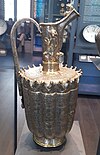
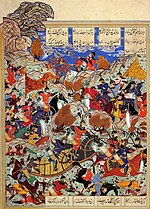

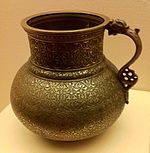
Herat was a great trading center strategically located on trade routes from Mediterranean to India or to China. The city was noted for its textiles during theAbbasid Caliphate,according to many references by geographers. Herāt also had many learned sons such asAnsārī.The city is described byEstakhriandIbn Hawqalin the 10th century as a prosperous town surrounded by strong walls with plenty of water sources, extensive suburbs, an inner citadel, a congregational mosque, and four gates, each gate opening to a thriving market place. The government building was outside the city at a distance of about a mile in a place called Khorāsānābād. A church was still visible in the countryside northeast of the town on the road toBalkh,and farther away on a hilltop stood a flourishingfire temple,called Sereshk, or Arshak according toMustawfi.[7][34][35][36][37]
Herat was a part of theTaheriddominion in Khorāsān until the rise of theSaffaridsinSistānunderYa'qub-i Laithin 861, who, in 862, started launching raids on Herat before besieging and capturing it on 16 August 867, and again in 872. The Saffarids succeeded in expelling the Taherids from Khorasan in 873.
TheSāmānid dynastywas established inTransoxianaby three brothers,Nuh,Yahyā,andAhmad.Ahmad Sāmāni opened the way for the Samanid dynasty to the conquest of Khorāsān, including Herāt, which they were to rule for one century. The centralized Samanid administration served as a model for later dynasties. The Samanid power was destroyed in 999 by theQarakhanids,who were advancing onTransoxianafrom the northeast, and by theGhaznavids,former Samanid retainers, attacking from the southeast.
Ghaznavid Era
Sultan Maḥmud of Ghazniofficially took control of Khorāsān in 998. Herat was one of the six Ghaznavid mints in the region. In 1040, Herat was captured by theSeljuk Empire.During this change of power in Herat, there was supposedly a power vacuum which was filled byAbdullah Awn,who established a city-state and made an alliance with Mahmud of Ghazni.[38]Yet, in 1175, it was captured by theGhuridsofGhorand then came under theKhawarazm Empirein 1214. According to the account of Mustawfi, Herat flourished especially under theGhurid dynastyin the 12th century. Mustawfi reported that there were "359 colleges in Herat, 12,000 shops all fully occupied, 6,000 bath-houses; besides caravanserais and mills, also adarwishconventand a fire temple ". There were about 444,000 houses occupied by a settled population. The men were described as" warlike and carry arms ", and they wereSunniMuslims.[7]Thegreat mosque of Herātwas built byGhiyasuddin Ghoriin 1201. In this period Herāt became an important center for the production of metal goods, especially inbronze,often decorated with elaborate inlays in precious metals.
Mongols
TheMongolslaid siege to Herat twice. The first siege resulted in the surrender of the city, the slaughter of the local sultan's army of 12,000, and the appointment of two governors, one Mongol and one Muslim. The second, prompted by a rebellion against Mongol rule, lasted seven months and ended in June 1222 with, according to one account, the beheading of the entire population of 1,600,000 people by the victorious Mongols, such that "no head was left on a body, nor body with a head."[39]
The city remained in ruins from 1222 to about 1236. In 1244, a local princeShams al-Din Kartwas named ruler of Herāt by the Mongol governor of Khorāsān and in 1255 he was confirmed in his rule by the founder of theIl-Khan dynastyHulagu.Shamsuddin Kart founded a new dynasty and his successors, especially Fakhruddin Kart and Ghiyasuddin Kart, built many mosques and other buildings. The members of this dynasty were great patrons of literature and the arts. By this time Herāt became known as thepearl of Khorasan.
If anyone asks thee which is the pleasantest of cities, Thou mayest answer him aright that it is Herāt. For the world is like the sea, and the province of Khurāsān like a pearl-oyster therein, The city of Herāt being as the pearl in the middle of the oyster.[7]
— Rumi,1207–1273 A.D.
Timurtook Herat in 1380 and he brought theKartid dynastyto an end a few years later. The city reached its greatest glory under theTimurid princes,especiallySultan Husayn Bayqarawho ruled Herat from 1469 until May 4, 1506. His chief minister, the poet and author in Persian and Turkish,Mir Ali-Shir Nava'iwas a great builder and patron of the arts. Under the Timurids, Herat assumed the role of the main capital of an empire that extended in the West as far as centralPersia.As the capital of the Timurid empire, it boasted many fine religious buildings and was famous for its sumptuous court life and musical performance and its tradition of miniature paintings. On the whole, the period was one of relative stability, prosperity, and development of economy and cultural activities. It began with the nomination ofShahrokh,the youngest son of Timur, as governor of Herat in 1397. The reign of Shahrokh in Herat was marked by intense royal patronage, building activities, and the promotion of manufacturing and trade, especially through the restoration and enlargement of the Herat's bāzār. The present Musallah Complex, and many buildings such as the madrasa ofGawhar Shad,Ali Shir mahāl, many gardens, and others, date from this time. The village ofGazar Gah,over two km northeast of Herat, contained a shrine that was enlarged and embellished under the Timurids. The tomb of the poet and mysticKhwājah Abdullāh Ansārī(d. 1088), was first rebuilt by Shahrokh about 1425, and other famous men were buried in the shrine area.
In the summer of 1458, theQara QoyunluunderJahan Shahadvanced as far as Herat, but had to turn back soon because of a revolt by his sonHasan Aliand also becauseAbu Said's march on Tabriz.[40]
In 1507, Herat was occupied by theUzbeksbut after much fighting the city was taken byShah Isma'il,the founder of theSafavid dynasty,in 1510 and the ShamluQizilbashassumed the governorship of the area. Under the Safavids, Herat was again relegated to the position of a provincial capital, albeit one of particular importance. At the death of Shah Isma'il the Uzbeks again took Herat and held it untilShah Tahmaspretook it in 1528. The Persian king,Abbaswas born in Herat, and in Safavid texts, Herat is referred to asa'zam-i bilād-i īrān,meaning "the greatest of the cities of Iran".[41]In the 16th century, all future Safavid rulers, from Tahmasp I to Abbas I, were governors of Herat in their youth.[42]
Modern history (1500-2023)[edit]
By the early 18th century Herat was governed by theAbdali Afghans.AfterNader Shah's death in 1747,Ahmad Shah Durranitook possession of the city and became part of theDurrani Empire.[11]


In 1793,Herat became independentfor several years whenAfghanistanunderwent a civil war between different sons ofTimur Shah.TheIranianshad multiple wars with Herat between 1801 and 1837 (1804, 1807, 1811, 1814, 1817, 1818, 1821, 1822, 1825, 1833).[12]The Iraniansbesieged the city in 1837,but the British helped the Heratis in repelling them. In 1856, they invaded again, and briefly managed to take the city on October 25;[12]it led directly to theAnglo-Persian War.In 1857 hostilities between the Iranians and the British ended after theTreaty of Pariswas signed, and the Persian troops withdrew from Herat in September 1857.[43][12]Afghanistan conquered Herat on May 26, 1863, underDost Muhammad Khan,two weeks before his death.[44]
-
Traffic passing on the road near the Herat minarets, 2005.
-
The two mausoleums with the minarets, July 2001.
The famousMusalla of Gawhar Shahof Herat, a large Islamic religious complex consisting of five minarets, several mausoleums along withmosquesandmadrasaswas dynamited during thePanjdeh incidentto prevent their usage by the advancingRussian forces.Some emergency preservation work was carried out at the site in 2001 which included building protective walls around theGawhar Shad Mausoleumand Sultan Husain Madrasa, repairing the remaining minaret of Gawhar Shad's Madrasa, and replanting the mausoleum garden.[45][46][47]
In the aftermath of theAfghan Civil War (1928–1929),Herat was the last stronghold ofSaqqawistresistance, holding out until 1931 when it was retaken by forces loyal toMohammad Nadir Shah.[48]


In the 1960s, engineers from the United States builtHerat Airport,which was used by theSovietforces during theDemocratic Republic of Afghanistanin the 1980s. Even before theSoviet invasionat the end of 1979, there was a substantial presence of Soviet advisors in the city with their families.
Between March 10 and March 20, 1979, theAfghan Armyin Herāt under the control of commanderIsmail Khanmutinied. Thousands of protesters took to the streets against theKhalqcommunist regime's oppression led byNur Mohammad Taraki.The new rebels led by Khan managed to oust the communists and take control of the city for 3 days, with some protesters murdering any Soviet advisers. This shocked the government, who blamed the new administration ofIranfollowing theIranian Revolutionfor influencing the uprising.[49]Reprisals by the government followed, and between 3,000 and 24,000 people (according to different sources) were killed, in what is called the1979 Herat uprising,or in Persian as theQiam-e Herat.[50]The city itself was recaptured with tanks andairborne forces,but at the cost of thousands of civilians killed. This massacre was the first of its kind since theThird Anglo-Afghan Warin 1919, and was the bloodiest event preceding theSoviet–Afghan War.[51]


Herat received damage during the Soviet–Afghan War in the 1980s, especially its western side. The province as a whole was one of the worst-hit. In April 1983, a series of Soviet bombings damaged half of the city and killed around 3,000 civilians, described as "extremely heavy, brutal and prolonged".[52]Ismail Khan was the leadingmujahideencommander in Herāt fighting against the Soviet-backed government.
After the communist government's collapse in 1992, Khan joined thenew governmentand he became governor ofHerat Province.The city was relatively safe and it was recovering and rebuilding from the damage caused in the Soviet–Afghan War.[53]However, on September 5, 1995, the city was captured by theTalibanwithout much resistance, forcing Khan to flee. Herat became the first Persian-speaking city to be captured by the Taliban. The Taliban's strict enforcement of laws confining women at home and closing girls' schools alienated Heratis who are traditionally more liberal and educated, like the Kabulis, than other urban populations in the country. Two days of anti-Taliban protests occurred in December 1996 which was violently dispersed and led to the imposition of a curfew.[54]In May 1999, a rebellion in Herat was crushed by the Taliban, who blamed Iran for causing it.[55]
After theU.S. invasion of Afghanistan,on November 12, 2001, it was captured from the Taliban by forces loyal to theNorthern Allianceand Ismail Khan returned to power (seeBattle of Herat). The state of the city was reportedly much better than that of Kabul.[5]In 2004,Mirwais Sadiq,Aviation Minister of Afghanistan and the son of Ismail Khan, was ambushed and killed in Herāt by a local rival group. More than 200 people were arrested under suspicion of involvement.[56]
In 2005, theInternational Security Assistance Force(ISAF) began establishing bases in and around the city. Its main mission was to train theAfghan National Security Forces(ANSF) and help with the rebuilding process of the country.Regional Command West,led by Italy, assisted theAfghan National Army(ANA)207th Corps.Herat was one of the first seven areas that transitioned security responsibility from NATO to Afghanistan. In July 2011, the Afghan security forces assumed security responsibility from NATO.
Due to their close relations, Iran began investing in the development of Herat's power, economy and education sectors.[57]In the meantime, the United States built aconsulatein Herat to help further strengthen itsrelations with Afghanistan.In addition to the usual services, the consulate works with the local officials on development projects and with security issues in the region.[58]
On 12 August 2021, the city wascapturedby theTalibanduring the2021 Taliban offensive.[59]
Geography[edit]
Climate[edit]
Herat has acold semi-arid climate(Köppen climate classificationBSk). Precipitation is very low, and mostly falls in winter. Although Herāt is approximately 240 m (790 ft) lower thanKandahar,the summer climate is more temperate, and the climate throughout the year is far from disagreeable, although winter temperatures are comparably lower. From May to September, the wind blows from the northwest with great force. The winter is tolerably mild; snow melts rather quickly, and even on the mountains does not lie long. The eastern reaches of theHari River,including the rapids, are frozen hard in the winter, and people travel on it as on a road.
| Climate data for Herāt (1958-1983) | |||||||||||||
|---|---|---|---|---|---|---|---|---|---|---|---|---|---|
| Month | Jan | Feb | Mar | Apr | May | Jun | Jul | Aug | Sep | Oct | Nov | Dec | Year |
| Record high °C (°F) | 24.4 (75.9) |
27.6 (81.7) |
31.0 (87.8) |
37.8 (100.0) |
39.7 (103.5) |
44.6 (112.3) |
50.7 (123.3) |
42.7 (108.9) |
39.3 (102.7) |
37.0 (98.6) |
30.0 (86.0) |
26.5 (79.7) |
50.7 (123.3) |
| Mean daily maximum °C (°F) | 9.1 (48.4) |
11.9 (53.4) |
17.9 (64.2) |
24.0 (75.2) |
29.6 (85.3) |
35.0 (95.0) |
36.7 (98.1) |
35.1 (95.2) |
31.4 (88.5) |
25.0 (77.0) |
17.8 (64.0) |
12.0 (53.6) |
23.8 (74.8) |
| Daily mean °C (°F) | 2.9 (37.2) |
5.5 (41.9) |
10.2 (50.4) |
16.3 (61.3) |
22.1 (71.8) |
27.2 (81.0) |
29.8 (85.6) |
28.0 (82.4) |
22.9 (73.2) |
16.1 (61.0) |
8.8 (47.8) |
4.7 (40.5) |
16.2 (61.2) |
| Mean daily minimum °C (°F) | −2.9 (26.8) |
−0.6 (30.9) |
3.8 (38.8) |
9.1 (48.4) |
13.3 (55.9) |
18.2 (64.8) |
21.2 (70.2) |
19.2 (66.6) |
13.2 (55.8) |
7.4 (45.3) |
1.0 (33.8) |
−1.4 (29.5) |
8.5 (47.2) |
| Record low °C (°F) | −26.7 (−16.1) |
−20.5 (−4.9) |
−13.3 (8.1) |
−2.3 (27.9) |
0.8 (33.4) |
9.7 (49.5) |
13.3 (55.9) |
8.4 (47.1) |
1.3 (34.3) |
−5.6 (21.9) |
−12.8 (9.0) |
−22.7 (−8.9) |
−26.7 (−16.1) |
| Averageprecipitationmm (inches) | 51.6 (2.03) |
44.8 (1.76) |
55.1 (2.17) |
29.2 (1.15) |
9.8 (0.39) |
0.0 (0.0) |
0.0 (0.0) |
0.0 (0.0) |
0.0 (0.0) |
1.7 (0.07) |
10.9 (0.43) |
35.8 (1.41) |
238.9 (9.41) |
| Average rainy days | 6 | 8 | 8 | 7 | 2 | 0 | 0 | 0 | 0 | 1 | 3 | 5 | 40 |
| Average snowy days | 2 | 2 | 1 | 0 | 0 | 0 | 0 | 0 | 0 | 0 | 0 | 1 | 6 |
| Averagerelative humidity(%) | 72 | 69 | 62 | 56 | 45 | 34 | 30 | 30 | 34 | 42 | 55 | 67 | 50 |
| Mean monthlysunshine hours | 149.3 | 153.5 | 202.5 | 235.7 | 329.6 | 362.6 | 378.6 | 344.8 | 323.2 | 274.0 | 235.0 | 143.1 | 3,131.9 |
| Source 1: NOAA (1959–1983)[60] | |||||||||||||
| Source 2: Ogimet[61] | |||||||||||||
Places of interest[edit]
- Foreign consulates
India, Iran and Pakistan operate their consulate here for trade, military and political links.
- Neighborhoods
- Shahr-e Naw (Downtown)
- Welayat(Office of the governor)
- Qol-Ordue (Army's HQ)
- Farqa (Army's HQ)
- Darwaze Khosh
- Chaharsu
- Pul-e Rangine
- Sufi-abad
- New-abad
- Pul-e malaan
- Thakhte Safar
- Howz-e-Karbas
- Baramaan
- Darwaze-ye Qandahar
- Darwaze-ye Iraq
- Darwaze Az Kordestan
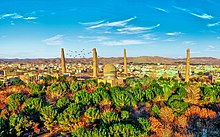



- Parks
- Park-e Taraki
- Park-e Millat
- Khane-ye Jihad Park
- Monuments
- Herat Citadel(Qala Ikhtyaruddin or Arg)
- Musallah Complex
- Musalla Minarets of Herat
Of the more than dozen minarets that once stood in Herāt, many have been toppled from war and neglect over the past century. Recently, however, everyday traffic threatens many of the remaining unique towers by shaking the very foundations they stand on. Cars and trucks that drive on a road encircling the ancient city rumble the ground every time they pass these historic structures.UNESCOpersonnel and Afghan authorities have been working to stabilize the Fifth Minaret.[62][63]
- Museums
- Herat Museum, located inside the Herat Citadel
- Jihad Museum
- Mausoleums and tombs
- Gawhar Shad Mausoleum
- Mausoleum of Khwajah Abdullah Ansari
- Tomb ofJami
- Tomb of khaje Qaltan
- Mausoleum ofMirwais Sadiq
- Jewish cemetery – there once existed an ancient Jewish community in the city. Its remnants are a cemetery and a ruined shrine.[64]
- Mosques
- Jumu'ahMosque(Friday Mosque of Herat)
- Gazargah Sharif
- Khalghe Sharif
- Shah Zahdahe
- Hotels
- Serena Hotel(coming soon)
- Diamond Hotel
- Marcopolo Hotel
- Stadiums
- Herat Stadium
- Universities
Demography[edit]
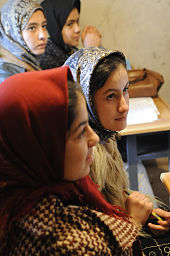
The population of Herat numbered approximately 592,902 in 2021.[3]The city houses a multi-ethnic society and speakers of the Persian language are in the majority.[65]There is no current data on the precise ethnic composition of the city's population, but according to a 2003 map found in theNational Geographic Magazine,Persian-speakingTajikandFarsiwanpeoples form the majority of the city, comprising around 85% of the population. The remaining population comprisesPashtuns(10%),Hazaras(2%),Uzbeks(2%) andTurkmens(1%).[66]
Persianis the native language of Herat and the local dialect – known by natives asHerātī– belongs to theKhorāsānīcluster within Persian. It is akin to the Persian dialects of eastern Iran, notably those ofMashhadandKhorasan Province,which borders Herat. This Persian dialect serves as thelingua francaof the city. The second language that is understood by many isPashto,which is the native language of the Pashtuns. The local Pashto dialect spoken in Herat is a variant ofwestern Pashto,which is also spoken inKandaharand southern and western Afghanistan. Religiously,Sunni Islamis practiced by the majority, whileShiasmake up the minority.[citation needed]
The city has high residential density clustered around the core of the city. However, vacant plots account for a higher percentage of the city (21%) than residential land use (18%) and agricultural is the largest percentage of total land use (36%).[67]
The city once had aJewishcommunity. About 280 families lived in Herat as of 1948, but most of them moved toIsraelthat year, and the community disappeared by 1992. There are four formersynagoguesin the city's old quarter, which were neglected for decades and fell into disrepair. In the late 2000s, the buildings of the synagogues were renovated by theAga Khan Trust for culture,and at this time, three of them were turned into schools and nurseries, the Jewish community having vanished. In 2016, the Taliban government approved conservation work on theYu Aw Synagogue,located in Herat's old city.[68]The Jewish cemetery is being taken care of by Jalil Ahmed Abdelaziz.[69]
Sports[edit]
- Professional sports teams from Herat
| Club | League | Sport | Venue | Established |
|---|---|---|---|---|
| Hindukush Stars | Shpageeza Cricket League | Cricket | Herat Cricket Ground | 2021 |
| Toofan Harirod F.C. | Afghan Premier League | Football | Herat Stadium | 2012 |
- Stadiums
- Herat Cricket Ground
- Herat Stadium
Notable people from Herat[edit]
Rulers and emperors[edit]
- Tahir ibn Husayn9th centuryAbbasid Caliphatearmy general, and the founder ofTahirid dynasty
- Ghiyasuddin Muhammad,was the emperor of the Ghurid dynasty from 1163 to 1202. During his reign, theGhurid dynastybecame a world power, which stretched fromGorgantoBengal
- Mīrzā Shāhrūkh bin Tīmur Barlas,Emperor of theTimurid dynastyof Herāt
- Abu Sa'id Mirza,ruler of theTimurid Empireduring the mid-fifteenth century
- Mīrzā Husseyn Bāyqarāh,Emperor of the Timurid dynasty of Herāt
- Shāh AbbāsThe Great,Emperor ofSafavid Persia
- Ahmad Shah Durrani,founder of theDurrani Empire
- Emir Dost Mohammad Khan,founder of theBarakzai dynasty,buried in the city
- Sultan Jan,ruler of Herat in the 19th century
Politicians[edit]
- Ahmad Maymandi11th centuryPersianvizierof theGhaznavid empire
- Ismail Khan,formergovernor of Herat ProvinceandMinister of Water and Energy
- Amena Afzali,politician
- Faramarz Tamanna,politician
Poets[edit]
- Asjadi,10th-11th century royalPersianpoet at the court of theGhaznavids
- Khwājah Abdullāh al-Herawi al-Ansārī,aPersianpoet of the 11th century
- Pur-Baha Jami,13th centuryIranianpoet,Punmaster, satirist, and often scathingsocial commentator,born inJam,spent his youth in Herat
- Nūr ud-Dīn Jāmī,aPersianSufipoet of the 15th century
- Nizām ud-Din ʿAlī Shīr Herawi,famous poet and scientist of theTimuridera
- Hatefi,aPersianpoet of the 16th century and nephew ofNūr ud-Dīn Jāmī
- Latif Nazemi,Persianpoet
- Nadia Anjuman(1981–2005) poet writing inDari
Scientists[edit]
- Abu Mansur Muvaffak Harawi,10th-centuryPersianphysician
- Abolfadl Harawi,10th-centuryastronomerunder the patroange of theBuyidsinRey,originally from Herat
- Ahmad ibn Farrokh,12th-century Persianphysician
- Taftazani,a Muslimpolymathof the 14th century
- Muhammad ibn Yusuf al-Harawi15th centuryPersianphysician
- Nimat Allah al-Harawi17th centuryPersianchronicler at the court of theMughal EmperorJahangir
Religious figures[edit]
- Fakhr ad-Din al-Razi,polymathandIslamic scholarof the 12th-century
- Hussain Kashefi,a 15th-century Persian prose-stylist andIslamic scholarand scientist
- Ali al-Hirawi al-Qari,from 17th century, considered to be one of the masters ofhadithand Imams offiqh
- Mujib Rahman Ansari(1982–2022),mullahand pro-Talibancleric
- Maulana Azad
Artists[edit]
- Ali ibn Abi Bakr al-Harawi12th and 13th centuryPersiantraveller and first knowngraffitiartist in theMuslimworld, originally from Herat
- Ustād Kamāl ud-Dīn Behzād,the greatest of the medievalPersian painters
- Mir Ali Heravi,prominentPersiancalligrapher andcalligraphyteacher ofNastaʿlīqscript in the 16th century
- Alka Sadat,Film producer was born here[70]
- Sonita Alizadeh,rapperand activist
Sports[edit]
- Nadia Nadim,Afghan-Danishfootball player,most influential and greatestAfghanfemale football player of all time, won the French league title in the2020-21season withParis Saint-Germain
- Hamidullah Karimi,Afghanfootballer, plays as a forward for Indian clubDelhi United FC
- Mohammad Rafi Barekzay,Afghanfootballer, plays as amidfielderforToofaan Harirod F.C
Others[edit]
- Gowhar Shad,wife ofShāh Rūkh Mīrzā
- Zablon Simintov,last remainingJewwho is believed to lived in Afghanistan
Economy and infrastructure[edit]
Transport[edit]
Air[edit]

Herat International Airportwas built by engineers from the United States in the 1960s and was used by theSoviet Armed Forcesduring theSoviet–Afghan Warin the 1980s. It was bombed in late 2001 duringOperation Enduring Freedombut had been rebuilt within the next decade. The runway of the airport has been extended and upgraded and as of August 2014 there were regularly scheduled direct flights toDelhi,Dubai,Mashad,and various airports in Afghanistan. At least five airlines operated regularly scheduled direct flights toKabul.
Rail[edit]
Railconnections to and from Herat were proposed many times, duringThe Great Gameof the 19th century and again in the 1970s and 1980s, but nothing came to life. In February 2002, Iran and theAsian Development Bank[71][72]announced funding for a railway connectingTorbat-e Heydariehin Iran to Herat. This was later changed to begin inKhafin Iran, a 191 km (119 mi) railway for both cargo and passengers, with work on the Iranian side of the border starting in 2006.[73][74]Construction is underway in the Afghan side and it was estimated to be completed by March 2018.[75]There is also the prospect of an extension across Afghanistan toSher Khan Bandar.
Road[edit]
TheAH76highway connects Herat toMaymanaand the north. TheAH77connects it east towardsChaghcharanand north towardsMaryin Turkmenistan.Highway 1(part of Asian highwayAH1) links it toMashhadin Iran to the northwest, and south via theKandahar–Herat HighwaytoDelaram.
Gallery[edit]
- Notable places in Herāt
-
Outside theShrine of Gazar Gah,c. 1939
-
Mausoleum ofMirwais Sadiq Khan,son ofIsmail Khan,who was killed in 2004 in clashes with theAfghan National Army
-
Shopping center
-
Pol-e Mālān,a historical bridge
-
Pillar ofMusallah Complex
-
Khwājah Abdullāh Ansārī shrine,aSufiof the 11th century
-
Gazar Gahcemetery
-
Tomb ofJāmi,a poet of the 15th century
-
TheJewishcemetery
-
View of Herat from a hill
Herat in fiction[edit]
- The beginning ofKhaled Hosseini's 2007 novelA Thousand Splendid Sunsis set in and around Herāt.
- Salman Rushdie's novelThe Enchantress of Florencemakes frequent reference to events in Herāt in the Middle Ages.
Sister cities[edit]
 Council Bluffs, Iowa,United States (since 2016)[76]
Council Bluffs, Iowa,United States (since 2016)[76] Divandarreh, Kurdistan,Iran (since 2021)
Divandarreh, Kurdistan,Iran (since 2021)
See also[edit]
References[edit]
- ^"Hadith - Book of Tribulations - Sunan Ibn Majah - Sunnah - Sayings and Teachings of Prophet Muhammad (صلى الله عليه و سلم)".sunnah.Archivedfrom the original on 2020-11-12.Retrieved2020-12-24.
- ^"OCHA - February Humanitarian Bulletin"(PDF).Archived(PDF)from the original on 2017-03-12.Retrieved2018-01-25.
- ^ab"Estimated Population of Afghanistan 2021-22"(PDF).National Statistic and Information Authority (NSIA). April 2021.Archived(PDF)from the original on June 24, 2021.RetrievedJune 21,2021.
- ^Herat - Definition and More from the Free Merriam-Webster DictionaryArchived2013-10-06 at theWayback Machine.Merriam-webster (2012-08-31). Retrieved on 2013-07-12.
- ^abPodelco, Grant (9 April 2008)."Afghanistan: Herat's Treasures Can't Compensate For Atmosphere Of Fear".Radio Free Europe/Radio Liberty.
- ^"Archived copy".Archived fromthe originalon 2019-04-30.Retrieved2021-07-26.
{{cite web}}:CS1 maint: archived copy as title (link) - ^abcdeḤamd-Allāh Mustawfī of Qazwīn (1340)."The Geographical Part of the NUZHAT-AL-QULŪB".Translated by Guy Le Strange.Packard Humanities Institute.Archived fromthe originalon 2013-07-26.Retrieved2011-08-19.
- ^"The Art of the Timurid Period (ca. 1370–1507)".Archived fromthe originalon 25 November 2016.Retrieved7 November2016.
- ^Periods of World History: A Latin American Perspective - Page 129
- ^The Empire of the Steppes: A History of Central Asia - Page 465
- ^abcSingh, Ganda (1959).Ahmad Shah Durrani, father of modern AfghanistanArchived2016-05-15 at theWayback Machine.Asia Publishing House, Bombay. (PDF version66 MBArchivedFebruary 7, 2013, at theWayback Machine)
- ^abcdNoelle-Karimi, Christine (2014).The Pearl in Its Midst: Herat and the Mapping of Khurasan (15th-19th Centuries).Austrian Academy of Sciences Press.ISBN978-3-7001-7202-4.
- ^"Bomb blast hits west Afghan city".BBC News.August 3, 2009.Archivedfrom the original on September 30, 2009.RetrievedMarch 26,2010.
- ^Hughes, Roland (4 August 2016)."Do tourists really go to Afghanistan?".BBC News.Archivedfrom the original on 1 May 2018.Retrieved21 July2018.
- ^"Herat City to Be Listed as UNESCO World Heritage Site".TOLOnews.Retrieved2021-07-04.
- ^"Taliban take Herat, Afghanistan's third-largest city, as they push towards Kabul".
- ^"Piranshahr in need of archaeological museum: Official".6 September 2022.
- ^"8,000 years old artifacts unearthed in Iran".7 January 2019.
- ^"Iranian archeologists hail find of relics built more than 5500 years ago".18 November 2023.
- ^Ahmadpour, Afsaneh; Kamkar Rouhani, Abolghasem; Ahmadi, Reza (2016)."Archaeological exploration of Tappeh Hissar, Damghan using forward and inverse modeling of Ground-Penetrating Radar data".Journal of Research on Archaeometry.2:1–16.doi:10.29252/jra.2.1.1.
- ^"Herat | City, Afghanistan, & Population | Britannica".10 January 2024.
- ^"The State of Cultural Heritage in the Ancient City of Aleppo".
- ^"UNOSAT".
- ^Vogelsang 2003,pp. 205–206.
- ^Translated by Herbert Cushing Tolman."The Behistan Inscription of King Darius".Vanderbilt University,Nashville, Tennessee. Archived fromthe originalon 2009-04-13.Retrieved2006-10-07.
- ^electricpulp."HERAT ii. HISTORY, PRE-ISLAMIC PERIOD – Encyclopædia Iranica".iranicaonline.org.Archivedfrom the original on 2016-09-01.Retrieved2011-09-15.
- ^The earliest recorded date of a bishop in Herat is 424."ASP Test Page".Archived fromthe originalon 2011-05-15.Retrieved2011-04-01.
- ^Abu Ja’far Muḥammad ibn Jarir Ṭabari,Taʾrikh al-rosul wa’l-moluk, pp. 2904-6
- ^Warfare in Chinese History.Brill. 2000. p. 118.
- ^Dupree, Nancy Hatch (1970).An Historical Guide to Afghanistan.Vol. First Edition. Kabul: Afghan Air Authority, Afghan Tourist Organization. p. 492.Archivedfrom the original on 2021-05-01.Retrieved2012-06-17.
- ^abcSkrine, Francis Henry;Ross, Edward Denison(2004).The heart of Asia: a history of Russian Turkestan and the Central Asian Khanates from the earliest times.Routledge.p. 117.ISBN0-7007-1017-5.
- ^Flood, Finbarr Barry (12 July 2022).Objects of Translation: Material Culture and Medieval "Hindu-Muslim" Encounter.Princeton University Press. p. 105.ISBN978-1-4008-3324-5.
- ^Musée du Louvre, Calligraphy in Islamic ArtArchived2011-11-10 at theWayback Machine
- ^The Encyclopaedia of Islam,Brill Publishers, Vol.3: H-Iram, 1986, Leiden, pp. 177
- ^Eṣṭaḵri, pp. 263-65, tr. pp. 277-82
- ^Ibn Ḥawqal, pp. 437-39, tr. pp. 424;
- ^Moqaddasi (Maqdesi), Aḥsan al-taqāsim fi maʿrifat al-aqālim, ed. M. J. de Goeje, Leiden, 1906, p. 307;
- ^Bahri, Hardev (1963).Lahndi Phonetics, with Special Reference to Awáṇkárí.Bharati Press Prakashan. pp. 10 and 11.
- ^Cambridge History of Iran,Vol.V, Ch.4, "Dynastic and Political History of the Il-Khans" (John Andrew Boyle), pp.315-6 (1968).
- ^Christoph Baum (2018).History of Central Asia.Vol. 4. p. 297.
- ^Savory, Roger (2 January 2007). "The Safavid state and polity".Iranian Studies.7(1–2): 206.doi:10.1080/00210867408701463.
Herat is referred to as a'zam-i bilād-i īrān (the greatest of the cities of Iran) and Isfahan as khulāsa-yi mulk-i īrān (the choicest part of the realm of Iran).
- ^Szuppe, Maria."HERAT iii. HISTORY, MEDIEVAL PERIOD".Encyclopædia Iranica.Archived fromthe originalon 14 March 2017.Retrieved13 March2017.
- ^Avery, Peter; Hambly, Gavin; Melville, Charles, eds. (1991).The Cambridge History of Iran (Vol. 7): From Nadir Shah to the Islamic Republic.Cambridge University Press. pp. 183, 394–395.ISBN978-0521200950.
- ^Ewans (2002).Afghanistan: A short History of its People and Politics.Perennial. pp.77.ISBN006-050508-7.
- ^"Mousallah Complex in Herat – Afghanistan – Tourist Spots Around the World".Touristspots.org.Archivedfrom the original on 21 January 2019.Retrieved21 January2019.
- ^Podelco, Grant."Afghanistan: Race To Preserve Historic Minarets Of Herat, Jam".Radiofreeeurope/Radioliberty.Archivedfrom the original on 30 July 2018.Retrieved21 January2019.
- ^"Tư vấn sản phẩm".Adventuretravelphotos.Archived fromthe originalon 25 January 2019.Retrieved21 January2019.
- ^"MOḤAMMAD NĀDER SHAH – Encyclopaedia Iranica".iranicaonline.org.Retrieved2019-04-23.
The following year, his enthronement was legitimated by a Lōya jerga (9-20 September 1930), whilst the final strongholds of Saqawi resistance were repressed in Kohdāman in 1930 (Eṣlāḥ I/67-70, 1930), and in Herat in 1931.
- ^Revolution Unending: Afghanistan, 1979 to the Presentby Gilles Dorronsoro, 2005
- ^Joes, Anthony James (18 August 2006).Resisting Rebellion: The History and Politics of Counterinsurgency.University Press of Kentucky.ISBN9780813191706.Archivedfrom the original on 28 May 2021.Retrieved5 October2020– via Google Books.
- ^"Failings of Inclusivity: The Herat uprising of March 1979 - Afghanistan Analysts Network".afghanistan-analysts.org.Archived fromthe originalon 2015-08-02.Retrieved2015-07-27.
- ^Afghanistan: The First Five Years of Soviet Occupation,by J. Bruce Amstutz – Page 133 & 145
- ^War, Exile and the Music of Afghanistan: The Ethnographer's Taleby John Baily
- ^"Archived copy"(PDF).Archived(PDF)from the original on 2017-10-12.Retrieved2018-01-01.
{{cite web}}:CS1 maint: archived copy as title (link) - ^Howard, Roger (4 July 2013).Iran in Crisis?: Nuclear Ambitions and the American Response.Zed Books.ISBN9781848137110.Archivedfrom the original on 28 May 2021.Retrieved7 June2020.
- ^"More arrests after Herat killing".BBC News.London. 2004-03-25.Archivedfrom the original on 2006-02-18.Retrieved2006-02-18.
- ^Motlagh, Jason.Iran's Spending Spree in AfghanistanArchived2009-05-27 at theWayback Machine.Time.Wednesday May 20, 2009. Retrieved on May 24, 2009.
- ^"U.S. Ambassador Karl W. Eikenberry Remarks at the Lease-Signing Ceremony for U.S. Consulate Herat"Archived2016-03-03 at theWayback Machine
- ^Varshalomidze, Tamila."Taliban captures Herat city after taking Ghazni".Al Jazeera.Retrieved12 August2021.
- ^"Herat Climate Normals 1959-1983".National Oceanic and Atmospheric Administration.Archived fromthe originalon 2023-05-04.RetrievedDecember 25,2012.
- ^"40938: Herat (Afghanistan) Synop Summary".G. Ballester Vallor.Archivedfrom the original on July 21, 2020.RetrievedJuly 21,2020.
- ^Bendeich, Mark (June 25, 2007)."Cars, Not War, Threaten Afghan Minarets".Islam Online.Retrieved2009-09-24.[permanent dead link]
- ^Podelco, Grant (July 18, 2005)."Afghanistan: Race To Preserve Historic Minarets of Herat, Jam".Radio Free Europe/Radio Liberty.Archivedfrom the original on 2016-03-04.Retrieved2009-09-24.
- ^A good description of the sites, including former afgahani jews who lived there, and of some locals, could be seen at "Quest for the lost tribes", a film bySimcha Jacobovici.
- ^"Welcome – Naval Postgraduate School"(PDF).nps.edu.Archived(PDF)from the original on 2011-06-06.Retrieved2009-09-07.
- ^"2003 National Geographic Population Map"(PDF).Thomas Gouttierre, Center For Afghanistan Studies,University of Nebraskaat Omaha; Matthew S. Baker, Stratfor.National Geographic Society.2003. Archived fromthe original(PDF)on 2017-09-12.Retrieved2011-04-11.
- ^"The State of Afghan Cities 2015, Volume 2".Archived fromthe originalon 2015-10-31.Retrieved2015-10-11.
- ^"Taliban government approves conservation work on historic synagogue in Afghanistan".The Art Newspaper.Retrieved6 June2024.
- ^"Relics of old Afghanistan reveal Jewish past".Reuters.24 June 2009.Archivedfrom the original on 2 January 2018.Retrieved1 January2018.
- ^Alka SadatArchived2016-06-25 at theWayback Machine,womensvoicesnow.org, Retrieved 7 June 2016
- ^Khaf-Herat railway,http:// raillynews /2013/khaf-herat-railway/Archived2017-12-20 at theWayback Machine
- ^afghanistan railways, 2014,http:// andrewgrantham.co.uk/afghanistan/railways/iran-to-herat/Archived2014-10-29 at theWayback Machine
- ^"Iran to Herat railway – Railways of Afghanistan".andrewgrantham.co.uk.Archived fromthe originalon 2014-10-29.Retrieved2014-06-07.
- ^Opening up Afghan trade route to IranArchived2016-01-01 at theWayback MachineRailway Gazette International2008-01-29
- ^"Rail Linkup With Afghanistan by March 2018".25 February 2017.Archivedfrom the original on 22 September 2018.Retrieved1 January2018.
- ^columnist, Erin Grace / World-Herald (21 July 2016)."Grace: Afghans arrive to embrace sister city Bluffs and to share their passion and hope".Archivedfrom the original on 2018-07-21.Retrieved2018-01-22.
Sources[edit]
- Frye, R.N. (1971)."Harāt".InLewis, B.;Ménage, V. L.;Pellat, Ch.&Schacht, J.(eds.).The Encyclopaedia of Islam, Second Edition.Volume III: H–Iram.Leiden: E. J. Brill. pp. 177–178.OCLC495469525.
- Vogelsang, W. J. (2003)."Herat ii. History, pre-Islamic period".InYarshater, Ehsan(ed.).Encyclopædia Iranica, Volume XII/2: Hedāyat al-mota'allemin–Herat VII.London and New York: Routledge & Kegan Paul. pp. 205–206.ISBN978-0-933273-75-7.
Attribution[edit]
- This article incorporates text from a publication now in thepublic domain:Chisholm, Hugh,ed. (1911). "Herat".Encyclopædia Britannica.Vol. 13 (11th ed.). Cambridge University Press. pp. 330–332.
External links[edit]
- Special report from the new complex in Herat - پالادیوم سنتر -گزارش ویژه از مجتمع جدید در هراتonYouTube
- Different and interesting Bazaars Herat Province Afghanistan 4 May 2022onYouTube
- Walking in Herat CityonYouTube
- بام هرات افغانستان 2019 Full HD BAAME HERATonYouTube
- برویم باهم پارک ترقي هرات قدم زدن Sep/2018 Walking through Park Taraghi of Herat AfghanistanonYouTube
- شهر هرات افغانستان 09.06.2018onYouTube
- Detailed map of Herāt city
- Map of Herāt and surroundings in 1942,Perry–Castañeda Library Map Collection,University of Texas at Austin









